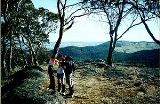
Rogaining
Encyclopedia

Navigation
Navigation is the process of monitoring and controlling the movement of a craft or vehicle from one place to another. It is also the term of art used for the specialized knowledge used by navigators to perform navigation tasks...
, involving both route planning and navigation between checkpoints using a variety of map types. In a rogaine, teams of 2-5 people choose which checkpoints to visit within a time limit with the intent of maximizing their score. Teamwork, endurance, competition and an appreciation for the natural environment are features of the sport. Championship rogaines are 24 hours long, however rogaines can be as short as 2 hours.
History
Rogaining can trace its roots back to 1947 when the first of many events with some of the features of rogaines was organized by the Melbourne University Mountaineering Club. These events led to the birth of the sport of rogaining in April, 1976, in MelbourneMelbourne
Melbourne is the capital and most populous city in the state of Victoria, and the second most populous city in Australia. The Melbourne City Centre is the hub of the greater metropolitan area and the Census statistical division—of which "Melbourne" is the common name. As of June 2009, the greater...
, Australia
Australia
Australia , officially the Commonwealth of Australia, is a country in the Southern Hemisphere comprising the mainland of the Australian continent, the island of Tasmania, and numerous smaller islands in the Indian and Pacific Oceans. It is the world's sixth-largest country by total area...
. The sport was named, rules were adopted and the world’s first rogaining association was formed (the Victorian Rogaining Association). Growth of the association and the sport occurred rapidly over the next decade.
The word rogaining is derived from the names of three of the founders, Rod Phillips, Gail Davis (née Phillips) and Neil Phillips (RoGaiNe, hence 'rogaining', 'rogainer' etc) who were all members of the Surrey-Thomas Rover Crew
Surrey-Thomas Rover Crew
The Surrey-Thomas Rover Crew now Surrey Thomas Rover Crew is best known for its role in the development of the sport of rogaining. The Rover Scout crew was formed in 1971 in Brighton, Australia It is part of Scouts Australia in the Australian State of Victoria. Soon after forming, the crew...
which organized the world's first rogaine. The name was formally adopted by the Victorian Rogaining Association at its inaugural annual general meeting in August, 1976 and accepted by Scouts Australia
Scouts Australia
Scouts Australia is an organisation for children and young adults from 6 to 26 years of age. Scouts Australia is part of the global Scouting movement and has been a national member of the World Organization of the Scout Movement since 1953...
and University bushwalking
Hiking
Hiking is an outdoor activity which consists of walking in natural environments, often in mountainous or other scenic terrain. People often hike on hiking trails. It is such a popular activity that there are numerous hiking organizations worldwide. The health benefits of different types of hiking...
groups to give the new sport an identity in its own right.
ROGAINE is also a backronym
Backronym
A backronym or bacronym is a phrase constructed purposely, such that an acronym can be formed to a specific desired word. Backronyms may be invented with serious or humorous intent, or may be a type of false or folk etymology....
for "Rugged Outdoor Group Activity Involving Navigation and Endurance".
World championships are held every two years, with the country chosen two years in advance by the International Rogaine Federation.
- 1st World Rogaining Championship (1992): Beechworth, Australia, about 200 teams
- 2nd World Rogaining Championship (1996): Mt Singleton, Western Australia, 640 participants in 271 teams
- 3rd World Rogaining Championship (1998): Kamloops, British Columbia, Canada
- 4th World Rogaining Championship (2000): Cristchurch, New Zealand
- 5th World Rogaining Championship (2002): Lesna, Czech Republic, 202 teams
- 6th World Rogaining Championship (2004): Arizona, USA, 380 participants from 15 countries and 33 U.S. states.
- 7th World Rogaining Championships (2006): New South Wales, Australia; 691 participants (311 teams), 125 from overseas
- 8th World Rogaining Championship (2008): Karula National Park, Estonia; 748 participants (339 teams) from 22 countries.
- 9th World Rogaining Championship (2010): Cheviot, New Zealand; 522 participants (251 teams)
- 10th World Rogaining Championship (2012): Prebuz, Czech Republic
Basic play
Teams of two to five members visit as many checkpoints as possible in the time allowed. Checkpoints are scored differently depending on level of difficulty in reaching them; therefore teams choose a strategy (for example, to visit many low score checkpoints). Teams travel entirely on foot, navigating by map and compass between checkpoints in terrain that varies from open farmland to hilly forest. A central base camp known as a "hash house" provides hot meals throughout the event and teams may return at any time to eat, rest or sleep. Teams travel at their own pace and anyone from children to grandparents can experience the personal satisfaction that comes from cross-country navigation at their own level of competition and comfort. Team members stay within earshot of each other.The length for a championship Rogaine is 24 hours, but shorter variations such as 6, 8, 12 and 15 hour events are also held (sometimes concurrently with a 24 hour event). Depending on the terrain, experienced rogaining teams can cover more than one hundred kilometers over the 24 hour period. There have also been longer events (dubbed "Endurogaines") lasting 48 and 50 hours. In their native Australia, Rogaines are usually held every month during weekends near full moons, with annual state championships and an annual national championship. They require dozens of volunteers to run, including course setters and caterers and are often attended by hundreds of participants. A competitive 24-hour rogaine requires a map area of around 250 km2 (~ 100 mi2), for relatively flat terrain; terrain with significant climbs may require far less or far more area, depending on the placement of checkpoints.
Variants
Other forms of rogaining are popular, particularly in AustraliaAustralia
Australia , officially the Commonwealth of Australia, is a country in the Southern Hemisphere comprising the mainland of the Australian continent, the island of Tasmania, and numerous smaller islands in the Indian and Pacific Oceans. It is the world's sixth-largest country by total area...
during the months when normal rogaines are not held because of the weather. Popular variations include:
- Metrogaine - An event of usually around 6 hours and held in predominantly urban areas.
- Cyclogaine - Usually run for 6 hours in areas with trails suitable for mountainbiking.
- Snogaine - Held in areas that are snowbound and participants may either snowshoeSnowshoeA snowshoe is footwear for walking over the snow. Snowshoes work by distributing the weight of the person over a larger area so that the person's foot does not sink completely into the snow, a quality called "flotation"....
or skiSkiingSkiing is a recreational activity using skis as equipment for traveling over snow. Skis are used in conjunction with boots that connect to the ski with use of a binding....
to reach checkpoints. - Paddlogaine - A rogaine on a water covered area, such as a set of interconnected lakes, participants can generally use any human powered watercraftWatercraftA watercraft is a vessel or craft designed to move across or through water. The name is derived from the term "craft" which was used to describe all types of water going vessels...
they want. - PubgainePub crawlA pub crawl is the act of one or more people drinking in multiple pubs or bars in a single night, normally walking or busing to each one between drinking.-Origin of the term:...
- A much shorter (2–3 hours) social event held in urban areas where all the checkpoints are pubs.
External links
- The International Rogaining Federation has a more complete history of the sport.
- The Australian Rogaining Association is the peak body for state rogaining associations in Australia.
- The New Zealand Rogaining Association
- The New South Wales Rogaining Association (Australia)
- The Victorian Rogaining Association (Australia)
- The Western Australian Rogaining Association (Australia)
- The Queensland Rogaine Association (Australia)
- The Japan Rogaining Association (Japan)
- The Laurentian Rogaine (Canada)
- The Russian rogaining site
- The Finnish rogaining site
- The Swedish rogaining site
- The Estonian rogaining site
- The Latvian rogaining site
- The Czech Association of Rogaining and Mountain Orienteering
- Rogaine Ireland - an annual event in Ireland.
- The Gear Junkie - "Rogaine Orienteering Race" feature article.

